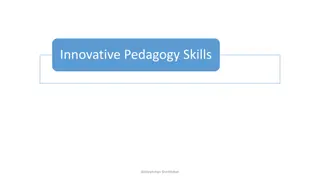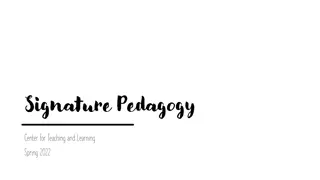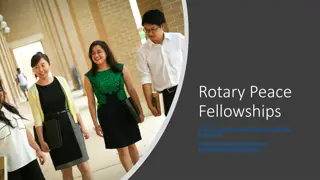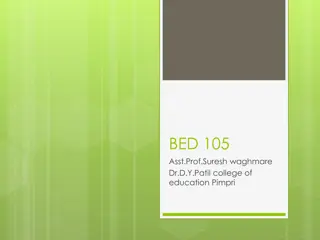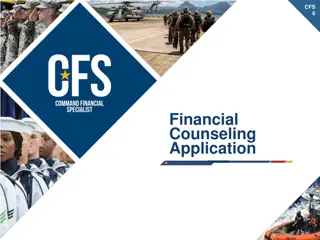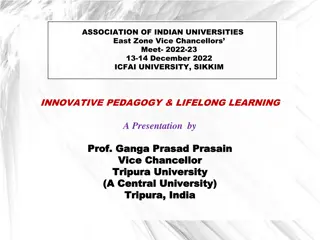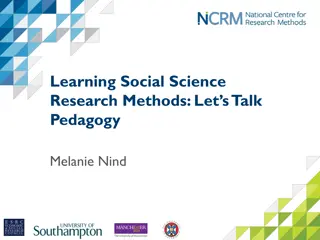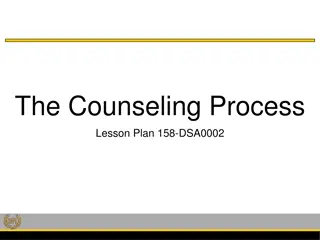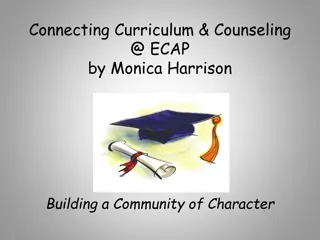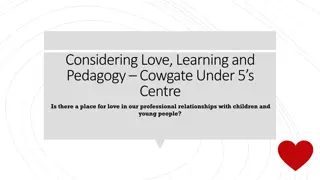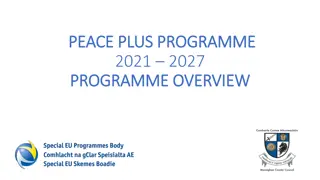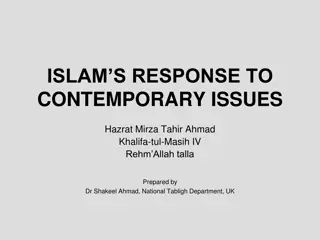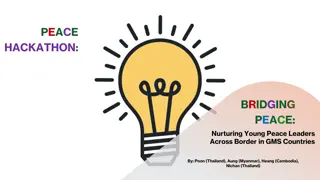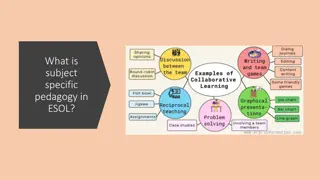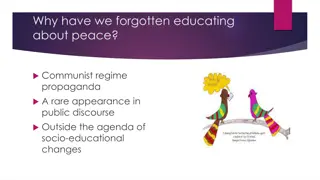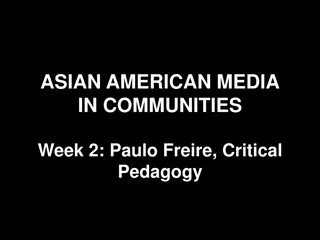Implementation of Peace Education Pedagogy in Learning and Counseling Seminar
This seminar focuses on the implementation of peace education pedagogy in the learning and counseling process. It delves into background, development, findings, and the significance of peace education in promoting a culture of peace through inclusive and quality education. Various international initiatives and lessons learned are discussed, aiming to address educational anomalies and conflicts, emphasizing the importance of peace education for sustainable development and human fulfillment.
Uploaded on Oct 05, 2024 | 3 Views
Download Presentation

Please find below an Image/Link to download the presentation.
The content on the website is provided AS IS for your information and personal use only. It may not be sold, licensed, or shared on other websites without obtaining consent from the author.If you encounter any issues during the download, it is possible that the publisher has removed the file from their server.
You are allowed to download the files provided on this website for personal or commercial use, subject to the condition that they are used lawfully. All files are the property of their respective owners.
The content on the website is provided AS IS for your information and personal use only. It may not be sold, licensed, or shared on other websites without obtaining consent from the author.
E N D
Presentation Transcript
IMPLEMENTATION OF PEACE EDUCATION PEDAGOGY IN THE PROCESS OF LEARNING AND COUNSELING Seminar Antarabangsa Intervensi Pengujian Psikologi Kaunseling Dalam Pendidikan & Organisasi, 8-10 November 2017 Universiti Pendidikan Sultan Idris Sunaryo Kartadinata Riswanda Setiadi Ilfiandra UNIVERSITAS PENDIDIKAN INDONESIA
BACKGROUND AND DEVELOPMENT OF PEACE EDUCATION PEDDAGOGY Focus FINDINGS AND FURTHER DEVELOPMENT
World Education Forum 2000 of learning, mutual understanding, essential life skills in the development of a culture of peace World Education Forum 2015 Convention of the Child Rights education to promote peace, human rights and social responsibility Lessons learned from several countries (Finland, Australia, Japan, Germany) One Asia Convention, 2014 Pioneering work by Loretta Navarro Castro in Miriam College, Philippines access Inspiring Events
Incheon Declaration of World Education Forum 2015 educational vision of 2030: ensure inclusive and equitable quality education and lifelong learning for all education is essential for peace, tolerance, human fulfilment and sustainable development peace should be the SUSTAINABLE DEVELOPMENT GOAL OF EDUCATION. SDG4 SDG4 Education Vision 2030
Education in crisis of learning to live together vs excellences Communication-collaboration pillars Educational malfunction "culture of testing "cultural literacy" Educational Anomalies Individual emphasis vs collective emphasis EDUCATION SEEMS TO FAIL
Student conflicts Students violent and deviant behaviors Un-peaceful Phenomenon: A Case of Indonesia Issuance of Ministerial Regulations, Minister of Education and Culture of the Republic of Indonesia No. 82 of 2015 on the Prevention and Countermeasures of Violence in Education
Peace is not only perceived as the absence of war, conflict, riots, violence, and conflict resolution, but also as mindset of peace and life skills for sustainable peace. Peaceful school culture should be created to learners mindset of peace and peaceful life. How Peace to be Perceived
A series of collaborative research Finland Australia Japan Germany Peace building is collaborative The creation of peace culture in school setting Focus on mind Teacher as a role model Model of Peace Education Pedagogy
Cognitive style and violent behavior trends among 4-5 grade children show : Tend to be undifferentiated styles that describe linear, dichotomous, and more lefty hemispheric thinking processes. There is a normative belief in child cognition that violence is justified to be reciprocated. Behavioral patterns or retaliatory actions tend to be done by reaction of aggression and physical action. Why Mind ?
The classroom learning atmosphere reflects the peace exemplified in the verbal and nonverbal behaviors of the students at the rate of 56% the learning environment, there still appears violent behavior among students. Teacher's efforts to create a peaceful class atmosphere are at 65.76%, the teacher's behaviors still contain actions that do not support the realization of an atmosphere of peaceful class optimally. The trend seemingly showed that Finland's predisposition of peace was more intrapersonal than Indonesian students. in We Need to Create Peaceful Classroom Atmosphere
Holistic, oriented towards cognitive development, affective and peaceful behavior as a whole Participatory, giving space for students to explore, share and cooperate Co-operative, giving students space to study and cooperate, rather than to compete Experiential, learning with direct experience in the class so that direct teachinhg can be minimized Key principles of development of peace education pedagogy
Areas of learning and guidance and counseling DASAR LAYANAN Five indicators of the peaceful classroom atmosphere : (1) listening to when others are speaking, (2) not isolating themselves or others in class communication, (3) saying politely, (4) only using good words, (5) respecting others Model of Implementation
significant changes occurred in the aspects of respect of others in female students of vocational school. But there is no significant change in other aspects, in male and female students of high school and vocational school Findings
A growing classroom atmosphere can encourage active involvement of students to participate, but such participation is not yet fully based on the internal strength of the self. Five indicators of peaceful-class atmospheric behavior appear not as a sequential developmental process but occur throughout the process. However, this tendency does not seem to be a strongly internalized force. Both in learning and counseling and counseling , there was (continued ) Continued
Both in learning and counseling and counseling , there was a dynamics that a dynamics that could be formulated into stages or elements of the process of development of mindset and peace behavior. Those stages or elements are: a. Structure development through the presentation of stimulation by teachers or counselors by confronting students with issues, tasks, and problems to learn. b. Development of transactions through class dynamics and involvement of all students in classroom processes and activities, through inter alia motivation, discussion, and assignment. c. Reinforcing responses and behavior patterns through rewards, praise, and the growth of perspectives forward. Continued
PEP model has not been statistically effective in developing mindset and peace behavior. But, it does not mean that PEP fails because the development of mindset and peaceful behavior by applying PEP is a complex process, requiring continuous effort, teacher s personal peace, and school leadership; Ideally, developing a culture of peace is participatory, multi-strategic, and stretches from individual, family, school, community, country to global level levels. Guidance and counseling (continued ) Analysis and Further Development
Guidance and counseling are leading sectors in the development of school peace culture. Teacher creativity is the key word for the implementation of peace education pedagogy to build a safe and peaceful classroom climate. Continued
POINT OF ARRIVAL PEACE EDUCATION EDUCATION FOR PEACE Safe , Peaceful, and Strong School Safe , Peaceful, and Strong School (ECOLOGY OF HUMAN LEARNING AND DEVELOPEMNT) (ECOLOGY OF HUMAN LEARNING AND DEVELOPEMNT) SUNARYO KARTADINATA, September 2017
School principals leadership should be developed; Prospective teachers should be introduced to peace pedagogy in their pre-service training; the establishment of a Joint Working Group representing ASEAN teacher education universities to formulate the pedagogical foundations of contextual peace and harmony with the cultural, religious and political orientation of each country, but within the framework of universally accepted values. Notes
SUNARYO KARTADINATA. 2017 8/26/2017



